THE FALL ELK RUT, RMNP, COLORADO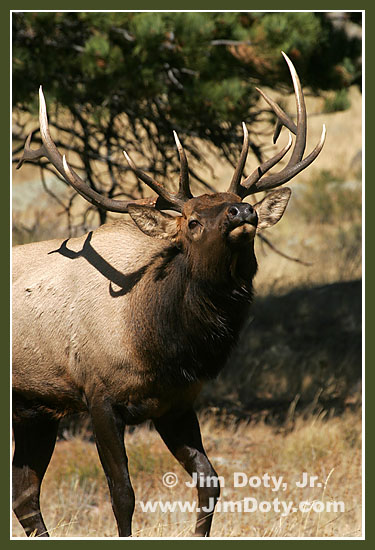 A bull elk struts his stuff, Rocky Mountain National Park, Colorado.
A bull elk struts his stuff, Rocky Mountain National Park, Colorado.
Photo copyright (c) Jim Doty, Jr.If you go to Rocky Mountain National Park during the fall rut, you are almost guaranteed to see large herds of elk. The rut begins in early September and ends in mid-October. The last week or two of September through the first week in October is a good time to go to see both elk at their best and fall color.
The elk are usually back in the trees during the day. In later afternoon to early evening, they come out into the meadows and the show begins. Large mature bucks have gathered their harems while younger bucks try to steal a cow or two. The big bucks run them off. Bugling is a delight to the crowds that gather to watch the spectacle. Visitors line the roads near the largest herds, sometimes clogging the roads in "elk jams". It's easy to find the elk, just head out in the evening and look for all the cars. The best places to look are in Moraine Park, Beaver Meadows, Horseshoe Park, and Hollowell Park. Refer to the park map, these locations aren't far apart and you can check out several in an evening.
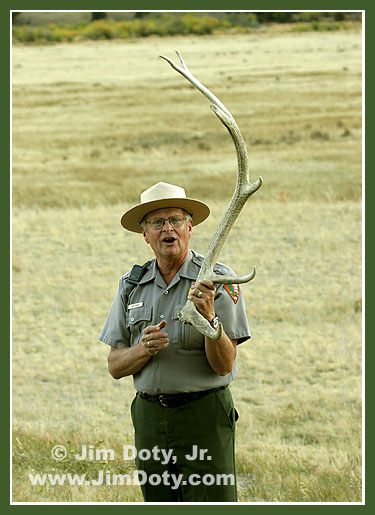 "Ranger Don" give his classic elk rut evening talk. Photo copyright (c) Jim Doty, Jr.
"Ranger Don" give his classic elk rut evening talk. Photo copyright (c) Jim Doty, Jr.To learn about the elk rut, go to one of the evening ranger talks. Details are in the park newsletter that you receive when you drive in, or ask at one of the visitor's centers. I will give you just a fews of the highlights.
It takes a lot of work to attract and hold a harem. First of all, elk need a big and impressive set of antlers. The antlers get bigger with each passing year. Older elk have the biggest racks.
Elk need to smell good to the cows, so they douse themselves with "elk cologne." That is a euphemism for elk urine. A bull elk has the interesting ability to control the spray from a wide, fine mist, to a narrow focused stream. When you see a big bull with his belly heaving up and down, he is spraying a fine mist of urine all over his belly. Then he lowers his head between his front legs and hits himself in the head with a narrow stream. What a stench. You will know it when you to smell it. The cows love it. Go figure.
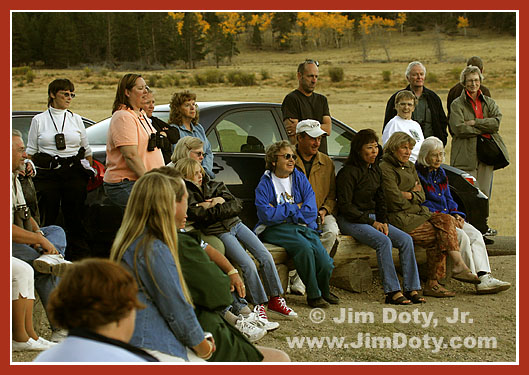 A group of park visitors is surprised to learn some of the details about the elk rut.
A group of park visitors is surprised to learn some of the details about the elk rut.
Photo copyright (c) Jim Doty, Jr.Bulls also need to look big and dark. Size again comes with age, but the bulls help themselves out a bit by going to the "elk spa." They roll in the mud to coat themselves. The caked on mud makes them look bigger and darker, another plus with the cows. It isn't hard to find mud to wallow in, they can always make their own. You guessed it. More smell.
Sound comes into play too. The more impressive the bugle, the better. Once again, the older, bigger bulls have the advantage. The younger bulls sound puny by comparison. Elk bugling can't really be described. A recording will give you something of an idea but you need to hear it in person to really appreciate it. There is nothing quite like that sound on a crisp fall evening.
Bigger bulls can often intimidate smaller bulls with a look or a bugle. Sometimes they chase them away. With bulls closer in size it can come down to a pushing match, antler to antler. Sooner or later one pushes the other away. If the loser falls, it can be fatal. Big bulls are mean and will gore a fallen bull. The average bull hide at the time of death has 30-50 gore marks.
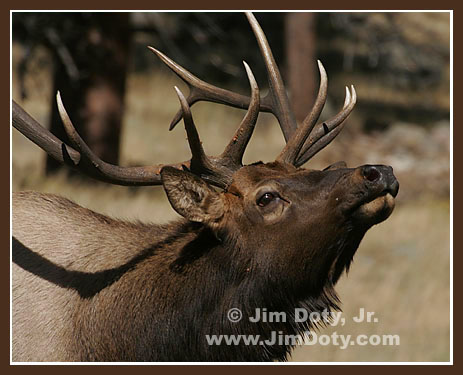 A bull elk right after running off some younger bulls, Rocky Mountain National Park, Colorado.
A bull elk right after running off some younger bulls, Rocky Mountain National Park, Colorado.
Photo copyright (c) Jim Doty, Jr.All the work of impressing and protecting a harem for 6 weeks is hard on a bull. They can lose 1/3 of their body weight during the rut. Many of them die over the winter. At birth, males slightly outnumber the females. A few years later, there is only 1 male for every 3 females. A few years later and the number of males is a small fraction of the number of females. Life is hard on the bulls.
The ranger drew a few parallels between bull elk and human males. Surely this isn't a fair comparison. After all, human males don't try to attract females by being impressive (fancy cars?), smelling good, looking buff, darkening their skin (tanning), or sounding good!
Photographing the elk usually means low light. That means higher speed films or higher ISO digital settings. ISO 400, 800 or even 1600 is not unusual as it gets darker and darker. If you are lucky, the elk will be out during the day after a sudden drop in tempreature or a change in the weather. That is what happened this week while I was there.
Elk are dangerous! Stay on the road and don't approach them. I heard a very foolish woman say "They're so tame" as she walked up to a young bull. Dumb. As someone once said, "Bull elk have two things on their mind in the fall, and you don't want to be on the receiving end of either one."
The elk rut is quite a show and swarms of visitors come to RMNP in the fall to watch. Why not join them?
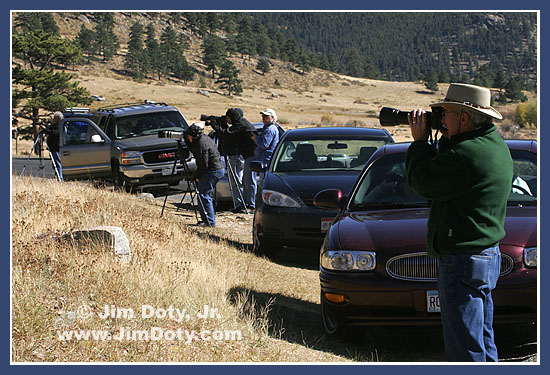 Photographers take advantage of a rare daytime opportunity to film a large herd of elk.
Photographers take advantage of a rare daytime opportunity to film a large herd of elk.
Photo copyright (c) Jim Doty, Jr.